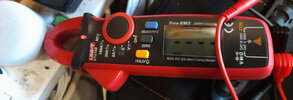Hello,
We've had an extension built a few years ago and are finally getting round to install some outdoor lights. The electrician at the time left the cables in place for us to connect the lights when ready without giving any further instructions. The plan was always to install two outdoor lights, one on either side of the extension and both operated via a light switch on the inside. When turning off the circuit breaker for the lighting circuit at the consumer unit today I noticed that only cable 1 stopped being live while 2 and 3 remained live. Upon investigation I found that only cable 1 responds to the light switch inside the house. Cables 2 & 3 remain live regardless of the position of the light switch and they also remain live if either the circuit breaker for the lighting or socket ring remain on. I have to turn off the circuit breakers for both rings before cables 2 & 3 stop being live. I've tested this with a LAP non-contact voltage detector pen. I know it is not exactly the gold standard but has worked reliably elsewhere in the house.
Normally I would get the electrician / builder back to explain this but given it has been a few years that is not really an option. Is this setup ok and if so, how should the cables be connected for the lights? Up until today I simply assumed cable 2-3 were an extension.

We've had an extension built a few years ago and are finally getting round to install some outdoor lights. The electrician at the time left the cables in place for us to connect the lights when ready without giving any further instructions. The plan was always to install two outdoor lights, one on either side of the extension and both operated via a light switch on the inside. When turning off the circuit breaker for the lighting circuit at the consumer unit today I noticed that only cable 1 stopped being live while 2 and 3 remained live. Upon investigation I found that only cable 1 responds to the light switch inside the house. Cables 2 & 3 remain live regardless of the position of the light switch and they also remain live if either the circuit breaker for the lighting or socket ring remain on. I have to turn off the circuit breakers for both rings before cables 2 & 3 stop being live. I've tested this with a LAP non-contact voltage detector pen. I know it is not exactly the gold standard but has worked reliably elsewhere in the house.
Normally I would get the electrician / builder back to explain this but given it has been a few years that is not really an option. Is this setup ok and if so, how should the cables be connected for the lights? Up until today I simply assumed cable 2-3 were an extension.



